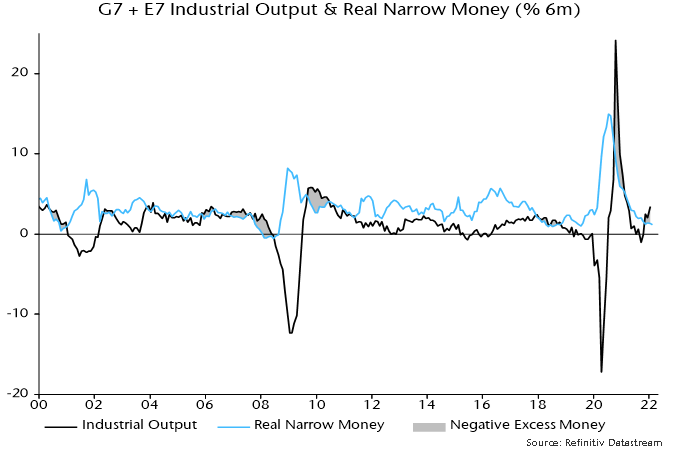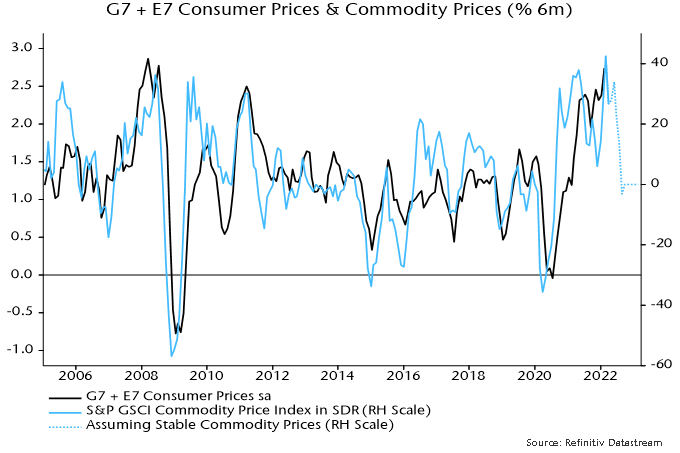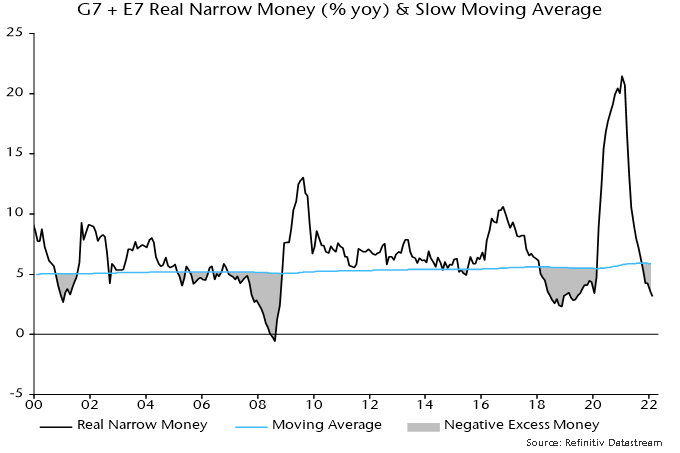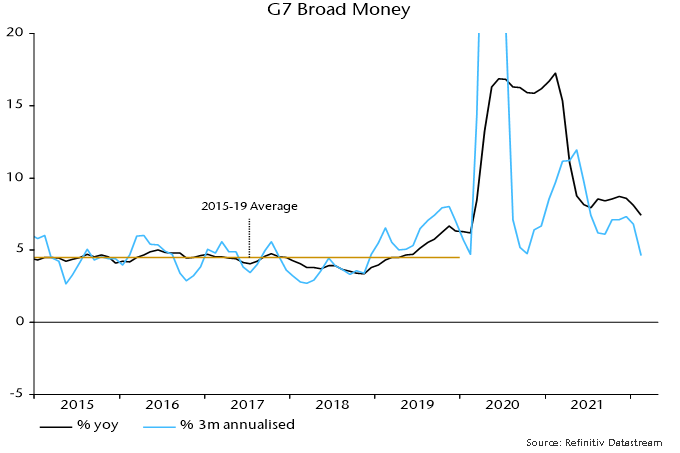L’argent, le moteur des marchés
A “monetarist” perspective on current equity markets
01 avril 2022 par Simon Ward
The monetary indicators followed here continue to give a negative signal for the global economy and risk assets. The indicators have been depressed by an inflation squeeze on real money balances and this drag is probably peaking. Any relief, however, may be offset by a further slowdown in nominal money growth due to over-aggressive withdrawal of stimulus by belatedly hawkish central banks.
Global equities relinquished all of their Q4 gain in early 2022 and fell to new lows following Russia’s invasion of Ukraine. As is often the case with responses to “news”, the latter move was subsequently reversed fully, with markets recovering strongly into late March. The monetary backdrop is not conducive to an extension of this rally.
Two measures of global “excess” money are tracked here – the differential between six-month growth rates of real narrow money and industrial output and the deviation of 12-month real money growth from a slow moving average. A previous post in this series at the start of the year noted that the second measure had turned negative and the first was likely to follow (confirmed in January). Historically, global equities underperformed cash on average when either measure was negative, with the weakest returns under “double-negative” regimes.
Could the measures return to positive territory soon? Chart 1 shows the components of the first gauge. The low level of global six-month real narrow money growth mainly reflects current high consumer price momentum – nominal money growth is only slightly below its 2010-19 average. CPI momentum may be peaking with commodity prices but the relationship in chart 2 suggests no significant relief until H2.
Chart 1

Chart 2

The negative gap between real money and industrial output growth also reflects a recent rebound in the latter as production constraints have eased and firms have rebuilt inventories. This will likely reverse – the real money slowdown suggests economic weakness and the stockbuilding cycle is scheduled to turn down. Again, however, a sufficient fall in output momentum may be delayed until H2.
The second excess money measure – the deviation of 12-month real narrow money growth from a moving average – is likely to remain negative for longer than the first, with 12-month inflation relief delayed until late 2022.
Chart 3

Both measures, moreover, could be depressed by a further slowdown in nominal money growth in response to recent and prospective central bank tightening – chart 4.
Chart 4

As well as performing poorly on average, equity markets have historically displayed distinct sector and style trends under double-negative excess money signals. Specifically, tech and other cyclical sectors (as defined by MSCI) underperformed on average, while energy and other defensive sectors outperformed. This pattern was evident during Q1.
Style-wise, high dividend yield and quality have outperformed on average under double-negative signals. The shift to an unfavourable environment has also often been associated with a set-back for momentum. So far, yield has outperformed but quality has lagged. This may reflect higher-than-usual exposure to tech and momentum in the quality basket, as well as the negative correlation of the style with long-term bond yields.
The Q1 surge in yields had not been expected here and occurred mostly after Russia’s invasion of Ukraine – the 30-year Treasury yield had remained below its March 2021 peak until the shock. The key drivers appear to have been stronger commodity prices – and an associated rise in inflation expectations – and a surprisingly aggressive hawkish policy shift by the Fed, mirrored to a lesser degree by other central banks.
The expected downswing in the stockbuilding cycle will weaken demand for commodities, offsetting the Russia / Ukraine supply shock and probably allowing price momentum to slow, if not turn negative. Central banks, meanwhile, usually abandon policy tightening plans as the downswing unfolds. The rise in Treasury yields, therefore, is judged unlikely to extend and may reverse, in turn suggesting that quality will resume its usual defensive status in negative monetary environments.
Medium-term interest rate prospects, of course, hinge on the issue of whether current inflation will prove “transitory”. “Monetarist” economists warned that the 2020 surge in global nominal money growth would feed through to a major inflation pick-up in 2021-22. Current money trends, however, are reassuring: G7 annual broad money growth has fallen significantly and the rate of increase in the latest three months was close to the pre-covid average – chart 5.
Chart 5

Will money growth rebound? It seems unlikely unless central banks completely abandon tightening plans and revert to zero rates and quantitative easing (QE). If quantitative tightening (QT) goes ahead, maintenance of even the recent slower pace of money growth will require solid expansion of bank lending. G7 monthly loan growth picked up into late 2021 but this is judged partly to reflect temporary inventory financing. Central bank lending surveys suggest moderate demand and were conducted before recent yield rises.
Regional / country money trends suggest particularly weak economic prospects in the Eurozone and UK, where six-month changes in real narrow money are negative – chart 6. The US could follow in March as CPI momentum rises further. Relative strength in Japan / China is due to a smaller inflation drag. Australia is a rare case of money trends still giving a positive economic signal.
Chart 6

A revival in Chinese real money growth from mid-2021 was, as expected, reflected in stronger activity data in early 2022. The economic recovery, however, has been stalled by renewed covid outbreaks and exports are at risk from global weakness. The hope here was that policy easing would lead to a more significant pick-up in nominal money growth by now. A reversal of food price weakness, meanwhile, suggests a rising inflation drag on real money growth.





